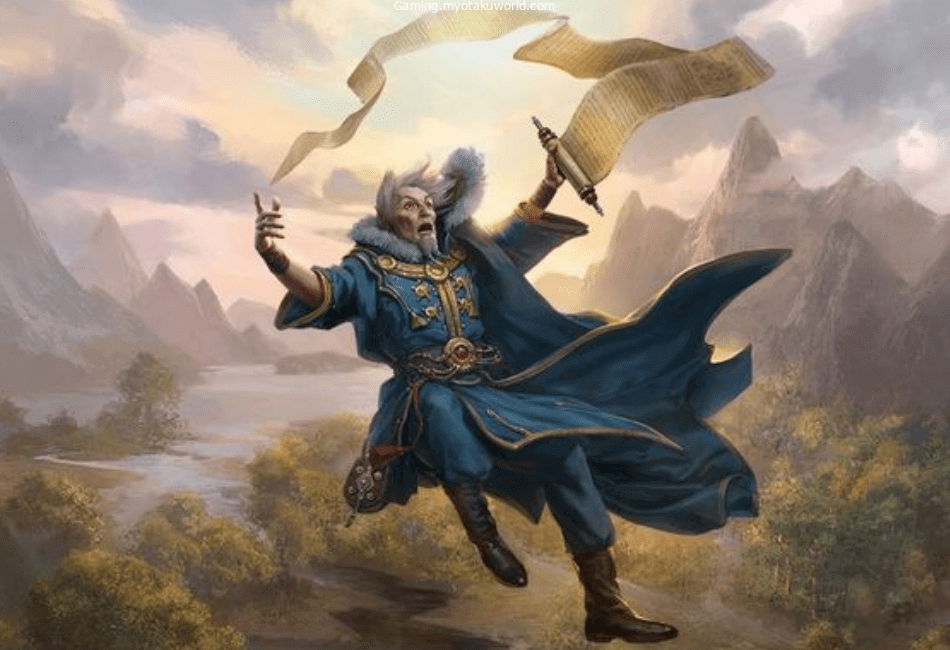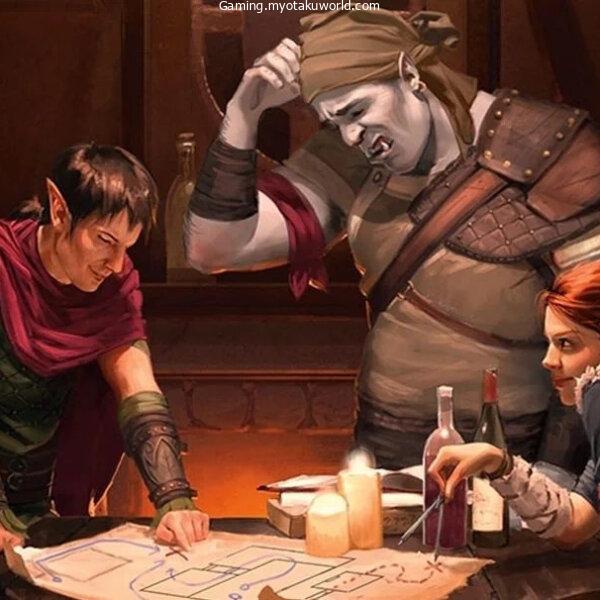This guide to Fall Damage in Dungeons and Dragons 5e can help settle disagreements about it. Some things in 5e have a lot of rules that can’t be argued with, but Fall Damage does not.
There are some government rules that can help guide you, but there are also some that aren’t said. It’s best to make these decisions before someone trips and falls so that no one feels bad.
The best thing about Dungeons and Dragons rules is that your D&D game can change them. If you want to make sure that every person dies because of an enemy, remove the chance of dying from falling damage.
- What is Fall Damage in DnD 5e?
- How to Calculate Fall Damage?
- How Fast Players Fall in 5e?
- Bludgeoning Resistance & Fall Damage
- Flying and Falling
- Exceptions to Falling
- Falling into Water
- Take Half Damage
- Ignore the first 20 feet
- Roll an Athletics Check
- Falling onto a Creature
- Repercussions of Falling
- Overriding Fall Damage Rules
- Homebrew Interference
- FAQs
What is Fall Damage in DnD 5e?
Fall Damage is the damage done to a Dungeons & Dragons character when it falls at least 10 feet.
If the character gets damage from falling, they are knocked over when they hit the ground. This could happen if a character falls off a high ledge, a bridge breaks, or the Fly spell stops working in the middle of a trip. Most of the time, a figure will take fall damage if they fall at least 10 feet.
On page 196 of the Player’s Handbook, it says that Fall Damage is considered Blunt damage for the purposes of the rules.
“Bludgeoning. Hammers, falling, and squeezing are examples of blunt force strikes. and the same amount of damage from blows.”
How to Calculate Fall Damage?

When it comes to figuring out fall damage, the rules are pretty easy to follow.
Every 10 feet of freefall does 1d6 damage (1d6 damage per 10 feet), up to a maximum of 20d6 damage.
So, you would have to fall from more than 200 feet to get the most damage from falling.
You can find these rules on page 183 of the Player’s Handbook.
“One of the most common dangers an explorer faces is falling from a high place.
A monster takes 1d6 bludgeoning damage for every 10 feet it fell at the end of a fall, up to a maximum of 20d6. If the monster takes damage from the fall, it lands on its back.
How Fast Players Fall in 5e?
As soon as you let go, you will drop 500 feet. So far, so good. So you won’t fall more than 500 feet on any of your turns. If you start falling from 501 feet, you fall 500 feet in one turn.
When it’s your turn again, that last foot will fall to the ground. This makes it easy to figure out and leaves little room for disagreements. If you start falling from 20 feet up, your turn is over when you hit the ground.
If you want to do something different and round the number, you can. It’s not against the rules of your campaign as long as the decision is made as a team, ideally before anyone falls.
Bludgeoning Resistance & Fall Damage
Fall damage is called Bludgeoning damage, so you’ll always be asked,
“If I am resistant to Bludgeoning, do I also have resistance to Fall Damage?”
The answer, as with most things in D&D, is “It depends.”
It depends on what’s giving you Bludgeoning pushback in the first place. Bludgeoning Resistance usually has limits on what sources can gain from it based on the other abilities.
On page 48 of the Player’s Handbook, the Barbarian’s Rage ability clearly says, “You have resistance to piercing, bludgeoning, and slashing damage.”
It’s a blanket statement that doesn’t say anything else. So, if a Barbarian is falling and using his Rage ability at the same time, he will have Resistance to damage from falling.
Now, let’s look at the Heavy Armor Master Feat on page 167. It says :
“Bludgeoning, piercing, and slashing damage from nonmagical weapons is reduced by 3 while you are wearing heavy armor.”
It says right there that the bonus is only for guns. Since falling damage isn’t considered a weapon, the player wouldn’t get any damage decrease.
As you can see, the way the source is written determines whether a character gets their damage reduction or Resistance.
Flying and Falling
If you are in the air and get “knocked prone,” you start to fall. During this time, you won’t be able to move at all. Since there are no “official” rules for people who can fly, your DM can work with this.
Since the player can fly, it’s fine if your DM lets you “catch” yourself by flapping your wings. If you can fly, you can also take less damage, as long as the DM lets you.
For example, there could be a rule that, as long as a flying creature is aware, falling does 50% less damage to it. Since your rule isn’t set in stone, you can change it.
Exceptions to Falling
There are always ways to break the rules. The alternatives to falling are easy to follow because they have more to do with making the best of a situation than with breaking a hard rule. The DMs can do that.
When you fall, put on your creative cap. You might not need to use the damage cap. These ideas can help you take as little damage as possible, so give them a try.
Catching on Something
You can either fall into something that stops your fall in the middle, or you can catch something with your hands. How you play this relies on your creativity and the skill of the DM.
For example, as you fall, you could ask the DM if you can see any trees or rocks. You might be able to slow down or catch one of them. This could help you take less damage.
Being Caught
If you get caught, you might not take as much damage. But it could also cause them to get hurt. If you are a Gnome and a big Orc is ready for you, it probably won’t hurt them.
But if the roles were switched, it could hurt the smaller person very badly. In a roleplaying game, these elements can mean the difference between life and death, so no detail is too small. That’s why it’s so important to be creative.
Athletics or Acrobatics Check
This is up to the DM to decide. If you can talk them into letting you roll for the fall, that would be great. If you were going to jump off a cliff or catch yourself, this would be a good idea.
Not all of these checks are easy to understand, and it’s easy to mix them up. But in short, athletics is based on strength, while acrobatics is based on dexterity.
You would probably use Acrobatics to keep yourself from falling or to land safely and Athletics to catch yourself or someone else.
Enhance Ability – Bard, Cleric, Druid, Sorcerer
Enhance Ability is a 2nd level spell that can be used in many ways. Cat’s Grace is a use that can help animals that fall.
The target has an edge on Dexterity checks when this ability is used. It also makes sure that the target doesn’t get hurt if they fall less than 20 feet.
The target can’t be incapacitated for this to work. If you cast the spell as a 3rd-level character or higher, you can choose one more monster to target for every slot level above 2nd. The power requires focus and can be used for up to an hour.
Feather Fall – Bard, Sorcerer, or Wizard
Just by looking at the name, you can tell what Feather Fall is. To use the 1st level of transmutation, you need a response. You can choose yourself or a creature within 60 feet of you when you use it.
When you use it, you can pick up to five Falling Creatures that are nearby. Until the spell stops, these creatures will only fall 60 feet per round.
If the creature falls while the spell is in effect, it doesn’t take damage from the fall and lands on its feet.
Slow Fall – Monk
The Monk class might be the most flexible. At 4th level, a Monk can use their Reaction to lessen the damage they take from falling by an amount equal to five times their Monk level.
So, let’s say they fall 100 feet, which would be 10d6, and say they get 40 damage from it. If the level of the Monk is 5, they will only take 15 damage.
Falling into Water
There are now rules about what to do if you fall into water. In Tasha’s Cauldron of Everything, they were first seen.
Players had to make up their own rules for falling into water and diving before Tasha’s Cauldron. There were three main ways to do it.
Let’s start with the legal way. Depending on who is running the game, the house rules might still seem more fair.
Most of the time, there are three things to do when you fall into water.
Take Half Damage
First, there’s the official way. If a character falls into water, they can make a DC 15 Strength check to try to land head first or feet first, based on how they want to land.
If they succeed, they don’t take any damage, but if they fail, they take 1/2 damage.
Before the official decision in Tasha’s Cauldron of Everything, the closest thing we had to an official rule was a tweet from Jeremy Crawford, the lead rules designer for DnD 5e, which said, “There’s no official rule for falling into water. Most of the time, as DM, I cut falling damage in half.
Since then, it looks like he has pushed for an official rule.
Ignore the first 20 feet
One of the most common ways to deal with falling into water is to ignore it…at least for the first 20 feet.
Most professional pools have high dives that are 20 to 30 feet high, and anyone can easily jump off of them into the water.
Still, if you move around or don’t know how to get into the water, you could hurt yourself and need a lifeguard.
Because of this, 20 feet has become the usual height from which anyone can fall without getting hurt.
Damage, on the other hand, is determined normally after 20ft. So, if a figure falls from 30 feet, they take 1d6 damage; if they fall from 40 feet, they take 2d6 damage, and so on.
If they fall 20 feet, they will just land in the water.
Roll an Athletics Check
What does a DM do when something comes up and they don’t know how to handle it?
Roll a d20.
Most people agree that it’s a Strength (Athletics) check, but it’s up to the DM to decide. Usually, this is where swim checks go, but when I’m the game master, I let my players choose Dexterity (Acrobatics) if they fall into water.
Swimming is definitely a Strength check, but diving could be seen as more of an Acrobatics and Dexterity check than a Strength check.
When this method is used, the player rolls whatever skill check the DM gives them, and that number, plus any modifiers, is deducted from the distance they fall.
For instance, a character with a +2 Strength modifier jumps off a rock that is 30 feet high. For their skill check, they roll an 18.
This is what it would look like:
Fall Distance – (STR MOD + D20) = Fall Damage Height OR 30 – (2 + 18) = 10 ft
This would mean that falling 30 feet into water was just as bad as falling 10 feet on solid ground… means that they would only take 1d6 damage.
It’s another way to get a good feel for what it would be like to fall onto hard concrete instead of jumping from a high dive into water.
Even if you are high enough, you will still get hurt, just like in the real world.
The problem with this method is that you have to check each person separately, which could slow down the game.
Falling onto a Creature
Another new rule for Falling Damage tells you what to do if you fall onto another creature. Whether you do it on plan or by accident, the outcome is the same.
The monster getting hit must make a Dexterity save of DC 15. If the spell doesn’t work, the damage is divided between the two animals.
There are also some rules about size. The creature that gets hit is knocked down unless it is at least two sizes bigger than the creature that just fell.
The next rule about size isn’t very clear: “If the creature falls into the space of a second creature and neither of them is Tiny…”
It doesn’t say what happens if a Tiny creature falls or is dropped on. You’ll have to make a house rule about that.
I think that if a Tiny creature is falling, the DC should be lower, and if it is being dropped on, it shouldn’t have a DC save.
Repercussions of Falling
In the Dungeon Master’s Guide, there is a part that helps the DM think of bad things that could happen if the player falls. Since falling is different from other ways of getting hurt, there are different ways to punish people who are careless.
If the person doesn’t get hurt, it’s because they didn’t take any damage. But if they fall 1000 feet and don’t die, they would be badly hurt. The two main accidents are both easy and bad.
Simple injuries could include sprains, broken bones, or a lot of bruises. There could be internal bleeding, parts that have been cut out, or something else just as bad. The point is to make sure that the hurt is real and fits the situation.
The player won’t break their arm if they fall ten feet and land on their ankle. But if they fall on their side, a rib could puncture an organ, which could lead to major problems in the future.
Overriding Fall Damage Rules
Just like in any other game, there are “house rules” for Dungeons & Dragons. House rules take precedence over government rules as long as most party members and the DM agree.
So, if you decide ahead of time that fall damage shouldn’t have a limit, take it away. If you decide for some reason that falling does less damage, change the 1d6 to a 1d4.
Lastly, if you want to fall 1,000 feet or just 200 feet each turn, you can do it. The Dungeons and Dragons rules are just suggestions.
For the team to have the most fun possible, they have to bend the rules a lot. So, cooperate. If you can’t decide what to do as a group, go back to the original rules.
Homebrew Interference
The original rules can’t cover races and groups that you make up on your own. So, if someone in your group has a homemade that protects them from falling damage, it’s up to the DM to decide if they can use it.
It doesn’t matter if the DM lets you make your own drinks or not. As long as the DM is fair, there shouldn’t be any anger about what they decide. The choice can be about the whole homebrew or just a few parts of it.
For example, let’s say a player creates a race that can’t get hurt by falling, speaks five languages, and can’t be stunned. It’s fine to get rid of or lower the effect that makes falling hurt more.
FAQs
Why is There a Fall Damage Cap in 5e?
I don’t know why 5e has a limit on fall harm. Maybe Wizards of the Coast gave experienced players a break because it would be so sad to die from falling at a high level that they felt sorry for them.
What Happens if You Fall On Someone in DnD 5e?
If you fall on someone, they would probably have to make a Dexterity saving throw or split the damage between the two characters. The DM is in charge of the specifics, of course.
How does Fall Damage work?
When a character falls, for every 10ft they fall they receive 1d6 bludgeoning damage.
0-9ft = no damage
10-19ft = 1d6 damage
20-29 = 2d6 damage
etc.
Why is there a Fall Damage cap in 5e?
The Fall Damage cap has no stated reason. Some people say that it gives high-level characters the chance to escape falls that would normally kill them for thematic reasons.
What happens if you Fall on someone in DnD 5e?
The person who is hit or who catches the person who is falling must make a DC 15 (Dexterity) save. If the spell works, it does no harm. If the spell doesn’t work, the damage is split between the two animals.









